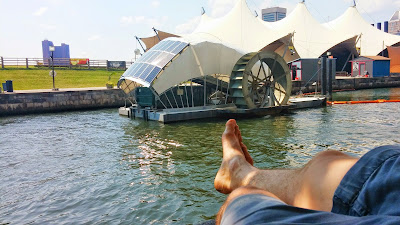 |
| Check out my feet |
The trash wheel sits right next to the Pier Six Box Office--it's the tent that you can see in the background. It collects trash from the water of Jones Falls, which is quite a bit. Heck, in May and June of 2014, it was picking up about 3-4 tons of trash a day! To learn more, I'd recommend checking out this EcoWatch article, How a Solar-Powered Water Wheel Can Clean 50,000 Pounds of Trash Per Day From Baltimore’s Inner Harbor.
As you can see from the photo, the wheel has a few key components.
- The solar panels (30 of them total that can generate 30 kwh of electricity on a sunny day)
- The floating dumpster, which can be detached and transported elsewhere
- Conveyor belt that lifts the trash to the bin
- The water wheel, which provides power to the conveyor belt
- The canvas covering, which protects the batteries and gears from foul weather
- The orange buoy lines, which direct the trash toward the conveyor belt
If you're having a tough time picking this out in the photo, please see my detailed drawing below.
Finally, I would highly recommend interacting with the wheel on Twitter, @MrTrashWheel. It's highly informative and pretty amusing. Every time I've tweeted at them, I get a quick response.
Finally, I would highly recommend interacting with the wheel on Twitter, @MrTrashWheel. It's highly informative and pretty amusing. Every time I've tweeted at them, I get a quick response.
 |
| If this isn't detailed enough, please email me at andrewpolich21@gmail.com. This drawing is an homage to waitbutwhy.com |
Ancient civilizations used water wheels for the first time, and during the Middle Ages, they spread widely. By means of gears and a shaft extending from the axle, the wheel power of the standing water is transferred to the upright shaft that turns the millstone inside the mill. On the mills' top floor, the millstones are set in casings. The ground material is then moved into the storage chests using shafts or slides after being fed into them with the use of a hopper.
ReplyDelete